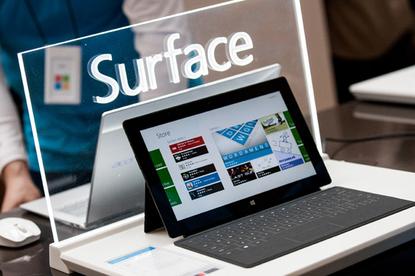Microsoft Surface Pro has problems but also big promise
- 15 February, 2013 14:32

Microsoft Surface Pro
I'm a big fan of the Microsoft Surface RT tablet. It's been my go-to product ever since I got one last year. So it was with great anticipation that I awaited the arrival of its big brother, Microsoft Surface Pro.
One of the annoying parts of Surface RT is that, while it has most of Microsoft Office, for some screwy reason Microsoft left out the best part of that package-Outlook-instead provided a stripped-down alternative. With Surface Pro, you can install Office and get that full email experience.
Both Surface RT and Surface Pro target the iPad, but they come at it from different vectors. Surface RT is the Microsoft spin on an iPad; there are limitations on what it can run, but the Windows Environment is more business friendly than an iPad. Surface Pro, meanwhile, is an ultrabook built like a tablet.
Video: Up Close with the Microsoft Surface Pro
Of the two, the Surface Pro it is actually the more innovative problem - but ultrabook and tablet technologies don't overlap, so Surface Pro may not measure up. It isn't a design flaw; the technology to do this right doesn't exist yet.
Best of ultrabook, tablet worlds isn't there yet
People got iPads because Steve Jobs convinced them that a product that was basically a netbook with a touchscreen and optional keyboard was a magical product. The magic-the combination of a light device for something with such a large screen, a 10-hour battery life, a rich set of apps and mostly marginal cloud services-was something that Apple could call unique.
Folks could carry these all day, without getting tired or needing a charger, and actually get stuff done. Yes, users sacrificed screen size and compatibility when they stopped using their Windows laptops, but iPad sales show they were OK with this.
Strangely enough, many people bought an iPad, tried to use it for work eventually bought a MacBook Air. Depending how you view the market, the MacBook air was either the precursor to the ultrabook or the first ultrabook. The Microsoft folks looked at this and saw value in creating a product versatile enough that users wouldn't have to carry both a tablet and an ultrabook.
Microsoft Surface Pro, then, is an ultrabook in tablet clothing. It is distinctly more convenient, and cheaper, than having to carry both devices. Unfortunately, using the two devices separately will likely provide a better experience that the two-in-one Surface Pro.
Ultrabooks typically have pretty good keyboards, sit nicely on your lap and have large screens-more than 13 inches in their most popular form. The weakest aspect of the Surface line, meanwhile, is the keyboard: It tends to flex, the touchpad is small, and the keys (even on the more expensive mechanical version, the Type Cover) don't have the throw many prefer in a laptop keyboard.
At the same time, ultrabooks are heavier than tablets and have about half the battery life. Both factors point to why folks prefer a tablet for things such as taking notes, watching media or reading.
Make a two-in-one product, then, and you have an ultrabook with a small screen and poor keyboard and a tablet that has too much weight and too little battery life.
Surface Pro 2.0 will be worth the wait
If Microsoft Surface Pro had twice the battery life and a better keyboard-one that was more than just an accessory-it would be a far more attractive offering and come close to the ideal device the market wants. Reduce the weight on top that and the Surface comes close to hitting a home run.
Luckily, solutions are near at hand. There are a number of ways to add battery life, such as additional battery capacity or accessories. Microsoft (or other vendors) will improve the keyboard over time. Finally, the next generation of Intel of processors will allow for better energy efficiency (and a longer battery life) as well as less weight.
With the right accessories and the technology improvements we can anticipate over the next two years, Microsoft Surface Pro could become far more compelling and approach the ideal of an ultrabook that can replace the iPad. (Keep in mind that, for folks to see the Surface Pro as a value, they have to compare it to both the MacBook Air and the iPad, but most will compare the Surface Pro to just the iPad and think it's too expensive.)
Until then, Surface RT serves as a better iPad alternative. All it needs is an Outlook client to become nearly perfect-and Microsoft could do that relatively quickly, without forcing customers to buy a new tablet. In the meantime, the upcoming Lenovo ThinkPad Helix may come closer to the ideal of a notebook that can morph into a usable tablet.
Microsoft did an amazing job trying to make an Ultrabook into a tablet, but the technology just isn't where it needs to be to make that possible. Surface Pro is a decent first shot, but I'd wait for the second act.
Rob Enderle is president and principal analyst of the Enderle Group. Previously, he was the senior research fellow for Forrester Research and the Giga Information Group.

